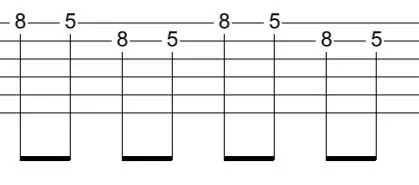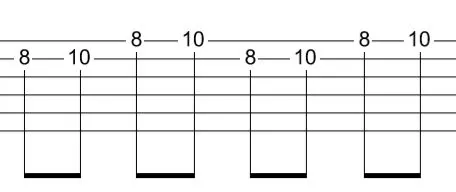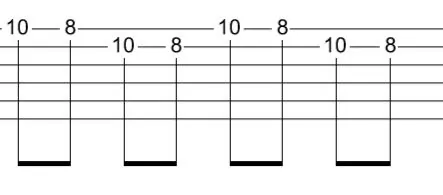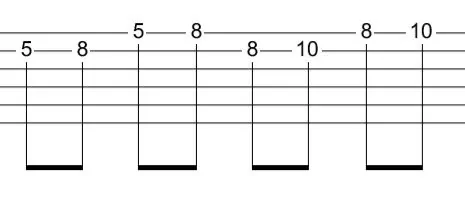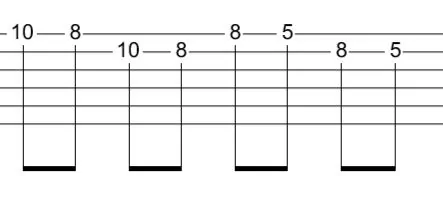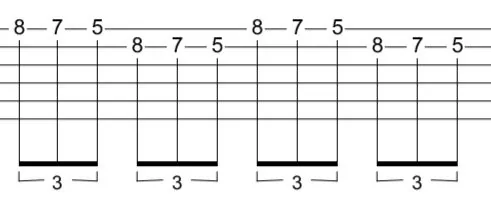In pursuit of speed, guitar players will go through great lengths. Unfortunately, there is no substitute for hard work when it comes to making those fingers fly and getting the fretboard burning up.
Speed on the guitar really came into the forefront of guitar players minds when Eddie Van Halen arrived on the scene with his two handed tapping licks and his incredible picking precision. Fast forward to the 1980s and the generation of teenagers who binged on EVH are now starting their own shred guitar revolution.
You have the likes of Paul Gilbert, Joe Satriani, Steve Vai and Yngwie Malmsteen holding down the fort for the metal players but shred guitar even crossed into the more mainstream with players like Steve Lukather flying the flag for shred while playing on sessions for artists such as Michael Jackson.
If you’re about to embark on your own shred guitar journey, this lesson will be a great place to get yourself kicked into gear. We are going to cover 15 speed building exercises that you can practise every day in your quest for speed.
Contents
Practise Tips
Before we get started, let’s cover some practise tips that will make this process work.
Stick to a Good Practise Schedule
Speed building is no easy task, it’s not going to happen overnight and it’s certainly not going to happen in a week. No one has ever gone from BB King to Yngwie Malmsteen without a bit of blood, sweat and tears.
I’d highly recommend keeping the exercises in this lesson in your regular (That should be daily, or as close to daily as possible). Playing these on a regular basis will allow the muscle memory to correctly develop along with the coordination that is required to play at these speeds.
The more regular you can practise something, the easier you can commit this to muscle memory and the easier it will be to retain that ability.
Use a Metronome, It’s Your New Favourite Tool
The ultimate key to speed lies in the precision and coordination between your fretting hand and your picking hand. A metronome will help you lock in and it will keep your speedy picking runs super tight and fluent.
Each of the exercises listed out in this lesson are suitable for use with a metronome. The ones that are eighth note exercises should be played at two notes per click and the ones that are triplet exercises should be played as three per click.
The great thing about using a metronome is that you are in control. To get started, learn the notes in the example and work out what sort of speed you can comfortably play this. If your metronome has a tap tempo (Most mobile and digital metronomes do), you can tap the approximate beat on which you are hitting the two or three notes.
Gradually Increase the Speed
When using the metronome, don’t be tempted to rush. Find your comfortable speed and master it. Once you master that speed, move up by increments of 5-10bpm. While this sort of increase might not be that audible as a big jump in speed, you will certainly feel it under the fingers.
The small increase will be enough to slightly shift your comfort zone, you will need to sit at this speed until it becomes natural. Then, go up again!
When working on speed as part of your daily routine, start at your comfortable speed and work up in 5-10bpm increases, getting progressively more comfortable with each speed increase. There will come a point where you feel that you can not physically go any faster or you can’t quite get it to sound clean. This is your ceiling for now.
Break Through that Ceiling
Once you’ve found your ceiling, stop for the day. The next day, start again at your comfortable speed and gradually work your way up the speed increases again. Perhaps on day 2 you might find that your “ceiling” speed is now a little easier. After a few days of pushing against this ceiling, you will find that it becomes a speed you can now play at.
Once you hit this stage, it’s time to keep on pushing because your next ceiling is waiting at a higher number ready to be smashed.
Keep Your Form Good
Speed building exercises can be intense and exhausting, both physically and mentally. In order to get your speed up, you will be putting some strain and pressure on your hands. Be mindful of this and don’t spend hours and hours working on the same exercises. Keep the practise sessions short but intense while keeping them regular.
Be mindful of your technique and posture when working on these exercises. Due to the extra strain you’ll be putting yourself under, it’s worth reassessing your technique to be sure you aren’t applying too much pressure as you fret and that you’re holding the guitar at a good angle with good posture.
Alternate Pick Everything
This might go without saying, but alternate picking will allow you to get the most out of these exercises and allow you to build your speed efficiently.
When playing straight eighth notes, every note on the beat will be a down and every note on the “&” will be an up.
| 1 | & | 2 | & | 3 | & | 4 | & |
| D | U | D | U | D | U | D | U |
When playing triplets, the first and third triplet of each bar will be “D U D” and the second and fourth triplet will be “U D U”.
| 1 | 2 | 3 | 4 |
| D U D | U D U | D U D | U D U |
Speed Building Exercises
Exercise 1
Guitar Tab showing an A Minor Pentatonic exercise in the first shape with ascending eighth notes.
This exercise is based around notes from the A Minor Pentatonic Scale and is played as eighth notes. Each group of two notes will fall on a separate beat and should be alternate picked throughout.
Exercise 2
Guitar Tab showing an A Minor Pentatonic exercise in the first shape with descending eighth notes.
This exercise is also from the A Minor Pentatonic Scale and it is the reverse of the previous exercise. You are working in a descending fashion in straight eighth notes, once again alternate picking throughout.
Exercise 3
Guitar Tab showing an A Minor Pentatonic exercise in the second shape with ascending eighth notes.
This exercise uses the second shape of the A Minor Pentatonic Scale and repeats the first idea as Exercise 1, alternate picking the ascending phrase with two notes per beat.
Exercise 4
Guitar Tab showing an A Minor Pentatonic exercise in the second shape with descending eighth notes.
This exercise uses the second shape of the A Minor Pentatonic Scale and mirrors the form of Exercise 2 with it’s descending eighth notes that should be alternate picked.
Exercise 5
Guitar Tab showing an A Minor Pentatonic exercise using the first and second shape with ascending eighth notes.
This exercise starts to make things a little more challenging as it adds a position shift. In this exercise, we are using the first and second shapes of the A Minor Pentatonic Scale. The rhythm is still straight eighth notes which are alternate picked but you want to pay attention to the position shift on beat three.
The first two beats stay in the first shape and the third and fourth beat move to the second shape. When position shifting during fast phrases, you want to be sure that you are cleanly arriving at the new position and not rushing this. Slow this down with the metronome and make sure that you move your whole hand to accommodate the shift.
Try using your index finger and little finger for the first position and your index and ring fingers for the second.
Exercise 6
Guitar Tab showing an A Minor Pentatonic exercise using the first and second shape with descending eighth notes.
This exercise is the reverse of Exercise 5 and works backwards through the same position shift. Working backwards through a position shift can present challenges at speed, the same hand movement must take place but you are now leading the movement with a finger other than the index finger.
Try starting the initial phrase with your ring finger handling the 10th fret and your index on the 8th. Once the first two beats have passed, you are them aiming to hit the 8th fret on the E string with your little finger. Don’t be tempted to quickly jump to this note with your index finger and this will cause further problems getting back down to the 5th fret note.
Exercise 7
Guitar Tab showing an A Minor Pentatonic exercise using the first and second shape with descending eighth notes in four note groupings.
This exercise might look scary on paper, but it’s not as bad as it seems. This is straight eighth notes descending through the second and first shapes of the A Minor Pentatonic Scale in four note groups.
Notice how the first note of each new group is the second note of the previous group. Take some time getting used to the flow of the notes through this before starting to build up speed. Once you can comfortably play through a long phrase, then set the metronome to a comfortable speed and start to tighten it up.
When dealing with longer phrases like this, it is useful to break them down into one bar phrases. You could even use each bar of this as a shorter exercise in it’s own right.
Exercise 8
Guitar Tab showing an A Minor Pentatonic exercise using the first and second shape with ascending triplet groupings.
For this exercise we are going to look at triplets. Across each beat we are playing three notes instead of the previous two notes we have done this far. Playing through passages with triplets will give the runs a more urgent and speedy feel.
This exercise follows the A Minor Pentatonic Scale first shape, right up until the final triplet of the third bar where it moves up to the second shape.
Each triplet group plays a series of three notes (two separate pitched noted, one is repeated), in a “high low high” pattern. So as we ascend the scale shape, we’re also descending slightly within each triplet. This is a common rock and metal style run to put into a speedy guitar solo.
The alternate picking here will be slightly different as outlined in the table at the start of the lesson, we will be doing “D U D” on the first and third triplets and “U D U” on the second and fourth triplets.
Take your time to learn the form of this before starting to push the speed up. This one takes a bit of going over to get tight. Be mindful of that little position shift right at the end too.
Exercise 9
Guitar Tab showing an A Minor Pentatonic exercise using the first shape with descending triplet groupings.
This exercise also plays through the A Minor Pentatonic Scale as a series of triplets, except this time we are descending from the top note of the shape down to the root note.
An easy way to remember the form of this exercise is to remember that each triplet group starts from the second note of the group before. This means, every three notes you play, you are actually only descending the scale by a further one note.
Exercise 10
Guitar Tab showing an A Minor Pentatonic exercise using all 5 shapes with descending eighth note groups and position shifts.
This exercise has a lot of position shifting and it uses the B and E strings of all five shapes on the A Minor Pentatonic Scale. This is played as straight eighth notes with a position shift every two beats.
Each two note phrase is played in reverse so as you shift position you are targeting the higher note of the two first. I’d recommend using your little finger and ring finger the target the higher notes and your first finger for the lower notes of each pair.
The third and fourth shapes (both of which appear in bar 2) aren’t identical frets on both strings. For the third shape, use your third finger for the 12th fret and your little finger for the 13th. When you get to the fourth shape, use your little finger for the 15th fret notes but you can experiment with your first and middle fingers between the 12th and 13th frets.
You may find it easier to play the 13th with a different finger or you may find it comfortable to just move the first finger.
Exercise 11
Guitar Tab showing a repetitive picking pattern with a moving first note causing some position shifts and stretches.
This exercise is once again straight eighth notes and is a fantastic speed builder. The first three bars of the pattern are all identical except for the first note which move down a fret each bar. This not only helps your accuracy but it also works on some stretching and position shifting. When you are starting the phrase with the 5th fret, you will need to move your hand down to the 5th before targeting the 10th fret on the E string with your little finger again.
Exercise 12
Guitar Tab showing an ascending triplet pattern using notes from the A Dorian Mode.
This ascending triplet exercise is a great way to get those fingers ready for playing some shred guitar. We are playing three notes per string here, this retains the form of the A Minor Pentatonic scale with the addition of the 7th fret on both strings (Taken from the Dorian Mode).
Use strict finger groupings for both strings here, first finger, ring finger and little finger and strict alternate picking throughout.
When alternate picking you’ll be starting all the B string triplets on a down and the E string triplets on an up.
Exercise 13
Guitar Tab showing an descending triplet pattern using notes from the A Dorian Mode.
This exercise is the same as Exercise 12 but in reverse. Starting from the highest note and working backwards in triplets.
Same rules apply here with finger patterns except you will be starting with the little finger. Picking is also worth considering, I always recommend starting descending triplet licks with an up stroke. If you start the first triplet with a down, the second triplet will need to be an up, which will involve skipping over the E string to precisely upstroke the B. While this is possible, you may find it more fluent to start with an up.
Exercise 14
Guitar Tab showing an ascending triplet pattern move up the fretboard with a range of position shifts and stretches.
This exercise is all triplets in an ascending, three note per string pattern. Each pattern will require the use of the first and little fingers but you can alternate the middle notes between your middle and ring fingers as needed.
The position shifts can be tricky in this pattern as the speed increases as they all contain three finger stretches so spend some time getting used to the form of this pattern before working your way up with the speed. Accuracy is everything with a fast pattern like this, you want to be sure you’re hitting every single note cleanly and not rushing anything.
Exercise 15
Guitar Tab showing an ascending triplet pattern that crosses all 6 strings and works across a large are of the fretboard with position shifts and string changes.
In this final exercise we have a triplet, three note per string pattern which ascends both up the strings and up the neck of the guitar. We will be covering everything from the 5th fret on the low E to the 18th fret of the high E in one move.
Every two groups of triplets, the position shift happens on the same string, Take bar one for example, the second beat is the 5th, 7th and 8th frets on the A string which then position shifts on the third beat to the 7th, 8th and 10th frets on the same string.
This exercise is certainly one to take your time with as there is a lot going on here and this requires accuracy from both your picking and your fretting hands. This combines all the skills in this lesson into one monster pattern.
Summary
All the exercises are written out here in the key of A Minor but you can transpose these to anywhere else on the guitar to suit. You may find some of the stretching exercises easier in a higher register as the frets are closer together.
Once you’ve mastered these, you could even try to throw a few of them into your own guitar solos to add some face melting speed to your lead passages.


